How to manage last-mile deliveries using Routetitan’s all-in-one routing platform
Businesses large and small are under pressure to meet growing demand for last-mile delivery. Meeting that demand while preserving your margins depends on achieving delivery efficiencies. Major carriers use sophisticated route optimization systems to deliver at scale. Now, you can access those efficiencies with Routetitan’s affordable, easy-to-use, off-the-shelf solution. Here’s how.
Emin Younan
Februari 26, 2021
Getting started: How to use Routetitan’s last-mile delivery optimization solution to save time and money
Matching the modern pace of delivery demand while still meeting consumer expectations requires those of us in the last-mile delivery industry to maximize efficiency and minimize costs. That’s why major carriers like DHL, UPS, and FedEx use sophisticated, proprietary route planning and management tools to control their fleets. These tools not only enable them to maximize efficiency but also maintain constant oversight of each vehicle and package.
Consumers benefit when companies implement route management technology, too. Better route control means that customers have more choices when it comes to when and how their packages are delivered. Advanced tracking capabilities enable customers to check on the status of their deliveries in real time.
Now, Routetitan’s all-in-one delivery planning and route optimization tool enables you to achieve many of these same functions and efficiencies without investing in a customized solution.
Once you add your data, Routetitan generates your most economical routes in a fraction of the time it would take you to attempt to optimize them yourself.
In this article, you’ll find the tips and instructions you’ll need to get your new account up and running quickly.
Ready to discover an easier way to make every minute count? Let’s go!
Your guide to maximizing efficiency with Routetitan
Your journey to maximizing efficiency and gaining greater visibility over your delivery tasks begins when you sign up for a 14-day free trial of the Routetitan app. Once you’ve created your account, you’ll be able to explore all of Routetitan’s features and manage your activities from a single dashboard.
This dashboard is where you’ll head to update your account settings, add drivers and vehicles, and manage your deliveries.
The right side panel of your Routetitan dashboard displays three main icons + text representing Projects, Vehicles, and Drivers. You’ll start here to begin the process of creating and optimizing your delivery routes.
Navigation tip: You can use the panel of icons located on the right side of your dashboard and open and close panels using the arrow or “x” buttons to navigate through the various menus and panels within your dashboard.
Before you can begin optimizing your delivery routes, the app needs to know what types of vehicles you have available. You’ll start by adding initial information about your resources using the Vehicles and Drivers categories. Later, you’ll create routes in the Project panel and be able to add more details about your vehicles and drivers.
Navigation tip: Within the app, the term “Project” refers to a set of stops or routes that you want to manage as a group. Depending on your delivery volume and business model, a single Project may include several vehicles, drivers and/or routes.
All of the information you need to add can be input using the in-app forms, Excel sheet upload, or API connection. We’ll stick to explaining how to add data using the single-entry form or file upload in this article.
Let’s take a look at how to add vehicles first.
Step 1️⃣: Add vehicles to your organization
Adding vehicles to your organization is fairly straightforward. You can choose to identify each vehicle in your fleet by assigning it a name or using its license plate number or other ID. Each vehicle you add must be assigned a type--indicating whether it is a motor vehicle or a bicycle--and you have the option to add the vehicle’s capacity.
You can enter or edit a vehicle’s data within the app by selecting it from the Vehicles menu.
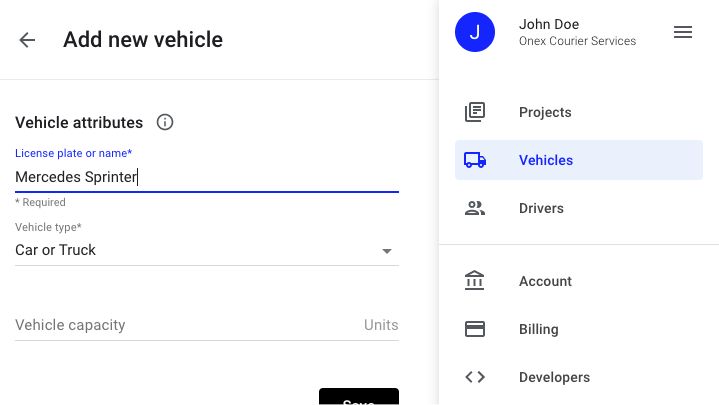
Or, save time by uploading your entire vehicle list via an Excel sheet.
Navigation tip: Use the provided template to create your Excel sheets to ensure that your information will sync correctly. You may also need to switch your spreadsheet’s formatting to text-only to avoid dropped zeros at the beginning of your vehicle IDs.
How should you name your vehicles? Your vehicle’s license number is an obvious identifier. But, you may want to combine this identifier with other details to make it easier to select vehicles from your queue. Extending your vehicle IDs can also help you with shift and schedule management.
Set your vehicle's capacity
The capacity designation allows you to enter a unit-based carrying capacity for each of your vehicles. If you also include a unit amount for each of your delivery stops, the app can use each vehicle’s capacity to determine how many vehicles you’ll need to handle all of your deliveries.
When assigning a capacity, choose the unit of measurement that makes the most sense for your business. Do you measure loads in cubic feet, number of stops or by number of packages? Accurately setting your vehicle capacities will help you better manage your resources and increase your efficiency.
Navigation tip: Did you try to delete a vehicle from your fleet inventory only to find it was still there? It may be because the vehicle is currently assigned to a locked route or published Project. You’ll need to remove the vehicle from active duty via the Projects panel first.
Step 2️⃣: Add drivers to your data set
You can
Select the Drivers button/icon on the right side of your dashboard to get started. You can manually add all your drivers.
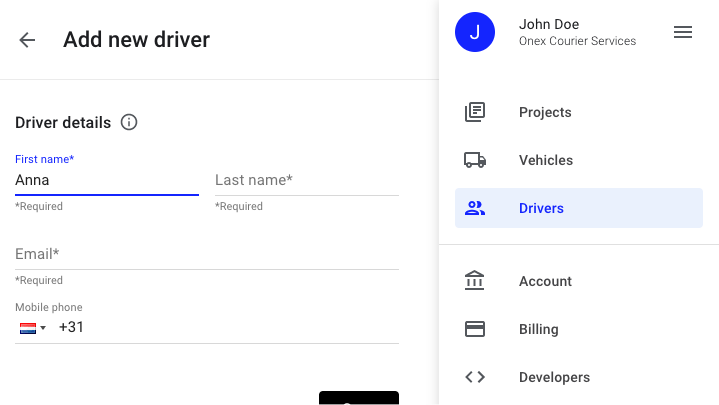
However, it is also possible to upload all your drivers using an Excel spreadsheet. To do this, choose the Upload drivers button to access and download the file template or enter your drivers directly using the in-app form. You’ll need to provide a first and last name plus an email address for each driver. Adding their mobile phone number is optional.
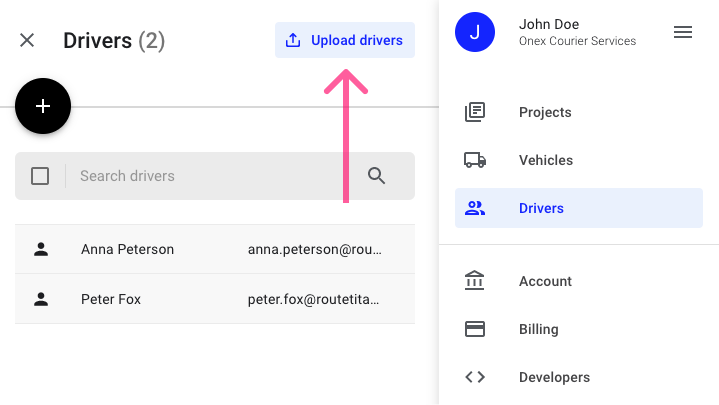
Navigation tip: Don’t forget the “+” sign and their country code for your drivers’ mobile phone numbers--but don’t include any spaces or other punctuation. You will need to set your spreadsheet’s format to “text” to avoid an error when entering the phone numbers.
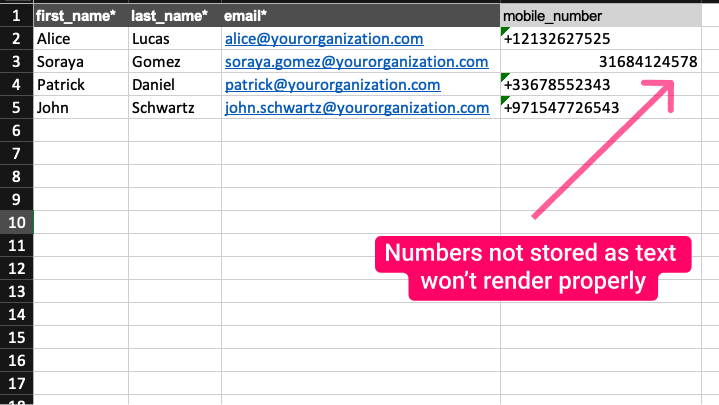
Once you select them to handle a specific route within a Project, you’ll have a chance to include shift and break information for each driver. These details are added as part of the information related to a route’s assigned vehicle in the Project panel.
Step 3️⃣: Begin a Project (create a route set)
Projects are your central route planning and optimization hub. This is where you’ll spend the most time adding information and making adjustments. Each Project can encompass up to 5,000 stops (depending on your plan) and last 24-hours in duration.
Designed to be flexible, you can create a single Project to cover all of a day’s deliveries or multiple Projects for each day. You can categorize your Projects by vehicle or delivery type, geographic regions, drivers’ shifts, warehouses, or any other method that allows you to better manage and control your fleet.
To create a new Project just click the Start new project button, then enter a Project name and a date.
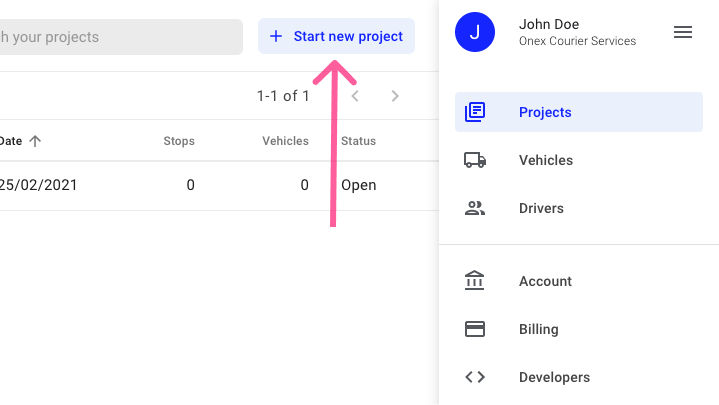
Navigation tip: Projects are date specific and will last no more than a day. If the stops you add to a Project cannot be completed in one day, they will be registered as unscheduled--not as delivered (very) late. You must enter a date for your Project to save it.
Then, select the Project you want to edit from your Project list and you can begin adding and editing its stops and vehicles.
Step 4️⃣: Add stops to your Project
You can add stops to a Project manually (similar to the method you would use when adding stops to a Google Maps route) or through a time-saving, bulk upload using an Excel sheet. In addition to this required data, you can also add important details such as each stop’s estimated load size and delivery window to your Excel sheet before uploading it. Customer notes and proof of delivery instructions can also be easily added to your file and uploaded in a single step.
In your Project panel, you’ll find a sub-panel where you can download a file template that includes both the required fields (type of stop, address, postal code and country code) and optional fields.
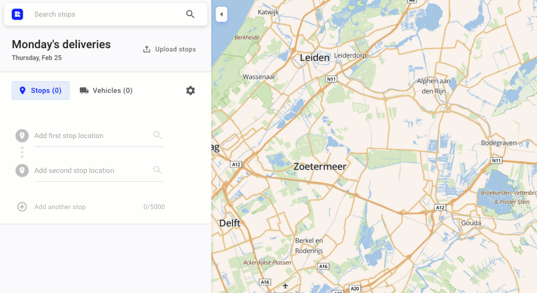
In my hypothetical Project, my delivery customers have requested different delivery times, and their load sizes vary. So, I’ve added this information to my Excel sheet.
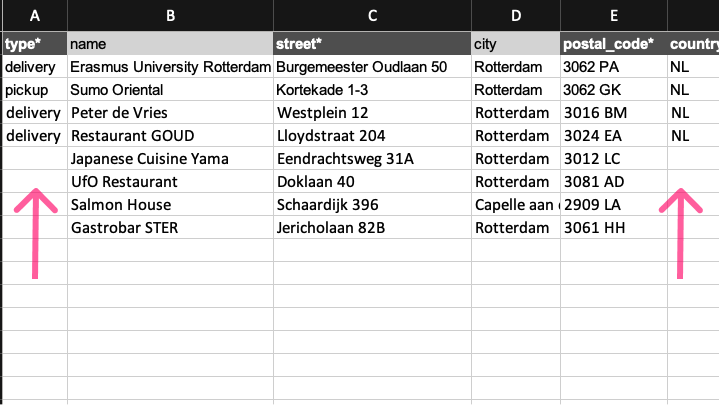
You may notice, though, that I forgot
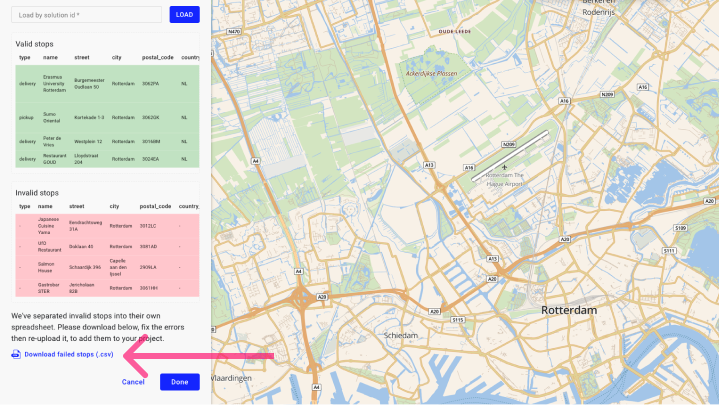
If you only have a few errors in a set of 5,000 stops, knowing which ones to correct definitely makes things easier. After I made my corrections, I uploaded my revised Excel sheet and selected Done to add the stops to my Project.
Navigation tip: If you uploaded a list of stops but they don’t appear on your Project panel, you may have forgotten to click Done before leaving the upload screen. Keep in mind that almost every panel requires you to click a confirmation button to save your results. 👍
Creating a Project to optimize a fixed daily route
If your business delivers to the same set of stops regularly, you don’t need to start from scratch to create a new Project each time. Instead, create and optimize all of your stops in a Project and save it. Give it a name that indicates that it is your standard delivery schedule or planning template.
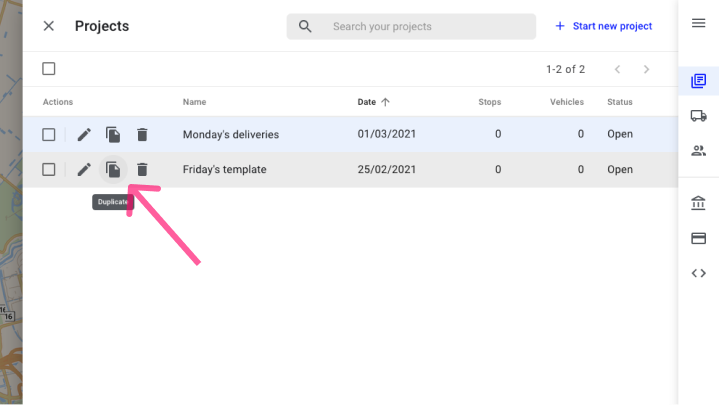
In the above example, I’ve started the process of creating templates for recurring daily stops. My hypothetical business brings paper goods to a regular set of customers, but their needs can vary from day to day. My “Friday's” Project template holds my stops data for customers that receive Friday deliveries. I can copy this template each week to create a new Project that reflects any additions or changes.
If your deliveries follow a regular pattern, experiment with whether it is faster for you to edit a copied Project or upload a new set of stops via Excel each day.
Navigation tip: Once a Project has expired (passed the scheduled delivery date), you will not be able to edit it. To reuse the Project as a template after it expires, duplicate it and assign it a new date.
Earlier I discussed creating a fleet inventory. From this inventory, you’ll select the vehicles that you want to assign to a specific Project. You’ll do this within the Project panel.
To assign a vehicle to a Project, check the box next to the vehicle ID and give it a start location. Remember, vehicles without a start location won’t be assigned routes or stops.
To save vehicle and driver details in the Project panel, you’ll select the Enable button. A vehicle must have a starting location entered before it can be enabled. To add the same starting address for all of your vehicles, select them all by checking the box next to each one’s ID, enter the start location in the details panel, and then click Enable.
Navigation tip: to select multiple vehicles that are adjacent, click the first vehicle, then press the shift key and click the last vehicle, after which all vehicles in between are included in the selection.
In the following image, you can see that two of the vehicles aren’t activated because they still need a start location.
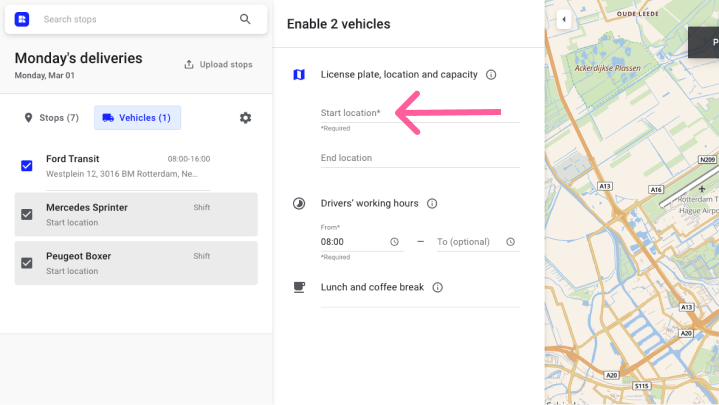
In the same panel where you’ll add your starting point, you can also add other details, including your driver’s shift, duration of break and break times. This information is critical if you are scheduling stops with narrow delivery windows.
Navigation tip: When you select the checkmark next to a vehicle to enable it in the Project Panel, a second panel opens. This is where you’ll add your starting point and other details. To access a specific section in this panel, click on that section’s heading.
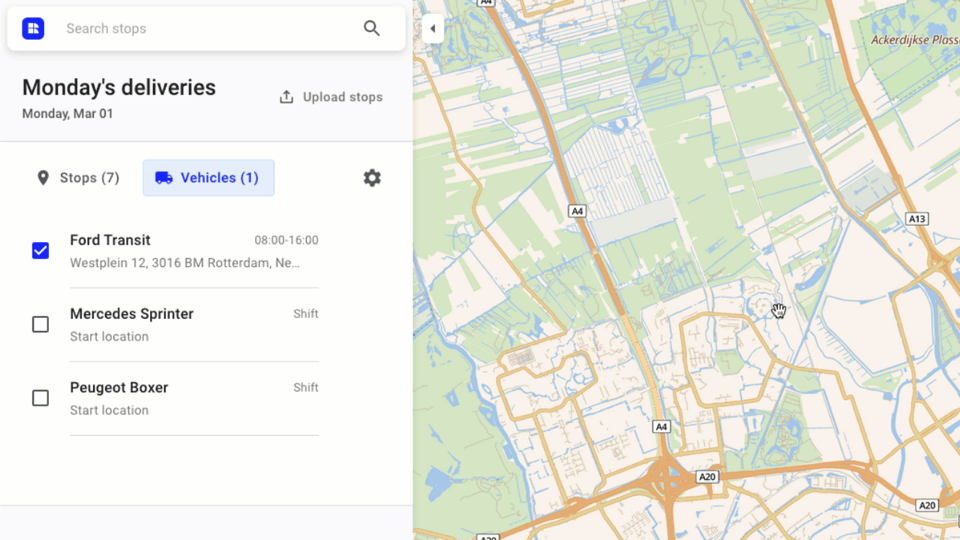
When you are first planning a Project, go ahead and select every vehicle that is potentially available to cover the day’s routes. The app will determine if you can use fewer vehicles or if you need to add capacity as part of the optimization process. If you unselect a vehicle, any details you added will be removed and you will need to re-enter them if you want to restore that vehicle to the Project’s inventory.
Step 6️⃣: Choose your optimization preferences
The best delivery route is the one that achieves all of your business goals, ranging from on-time delivery to reduced labor costs. So, Routetitan allows you to set your optimization preferences to align with your goals.
To get started, click the gear icon on your Project panel. This will take you to the Project settings where you can:
Choose between miles and kilometers
Set default load and delivery durations
Indicate whether late stops and backhauling are allowed
Indicate whether departure times are fixed or flexible
Choose between optimizing your routes for the shortest distance or the fastest delivery time
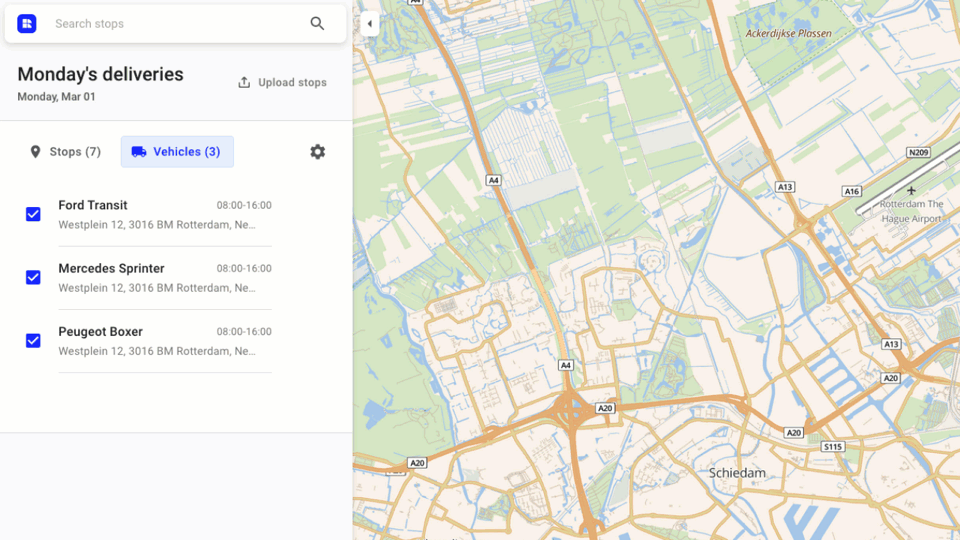
Adjust these settings to maximize your resource utilization in alignment with your business practices.
The “Allow backhaul” (allowing vehicles to return to depot to load more stops) feature is particularly beneficial if your vehicles are filled to capacity at the start of each shift but have time to cover another route later in the day. How do you incorporate returns to the warehouse into your vehicle’s route so that you keep your vehicles busy all day?
You could add your warehouse as a pickup stop with a narrow window timed so that the truck arrives when it is ready for a refill. But the results might not be optimal. Routetitan’s backhaul feature automates the return and refill process by instructing the app to send your vehicles back to their starting point to reload and begin a new route when doing so is most efficient.
Step 7️⃣: Make the route optimization magic happen
You have your stops uploaded, your vehicles selected and you have chosen how you want to optimize your routes. Now, it’s time to click the magic wand and see the results.
In my example, I’ve included 50 stops and 5 vehicles that will all start at the same location. I’m going to optimize my route for the fastest delivery time without backhauling or late stops.
Now, let’s see what happens.
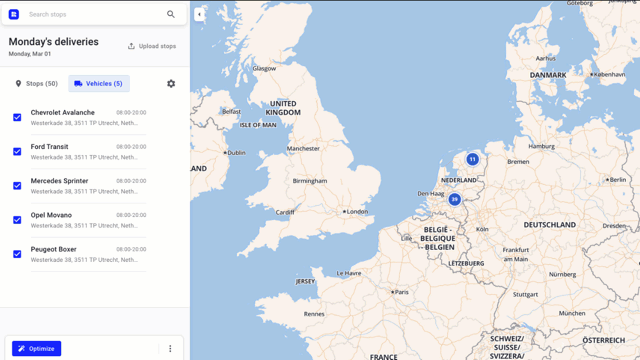
Although I enabled five vehicles, my results show that I can finish all my stops with just three vehicles! You have the ability to hide the empty vehicles, or in case you want to use them anyway, move or drag-and-drop stops from one vehicle to another.
Step 8️⃣: Publish and deliver your instructions to your drivers
Did you see how quickly I got the results for my 50-stop Project?
Now, I need to get those instructions to my drivers. I’m going to publish my route so it’s saved, and then send the instructions to each driver.
You’ll do the same to deliver your completed routing instructions.
To assign drivers select the drivers icon from the Project optimization panel to pull up your list of available drivers. Then click on a driver’s name and drag it to the route to make the assignment.
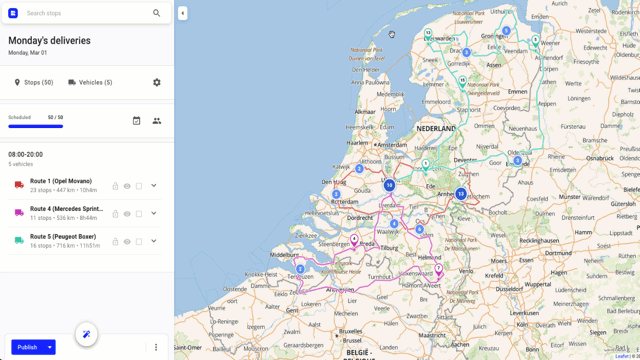
To switch drivers, just drag the name of the new driver to the route.
Before you hit publish, click the arrow next to the Publish button and finalize your preferences.
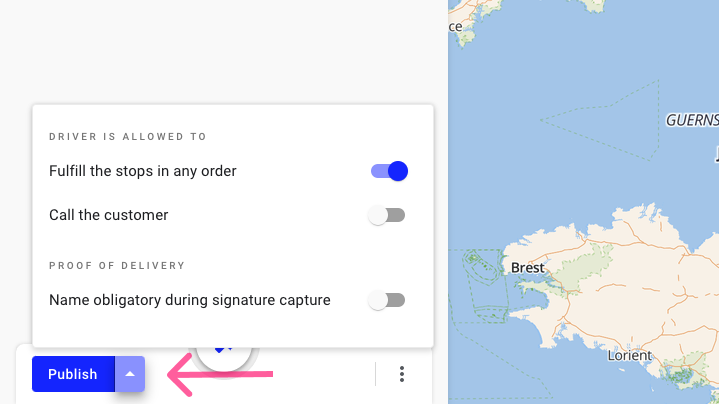
If you change in your project after you’ve published it you’ll be alerted that you need to republish the update.
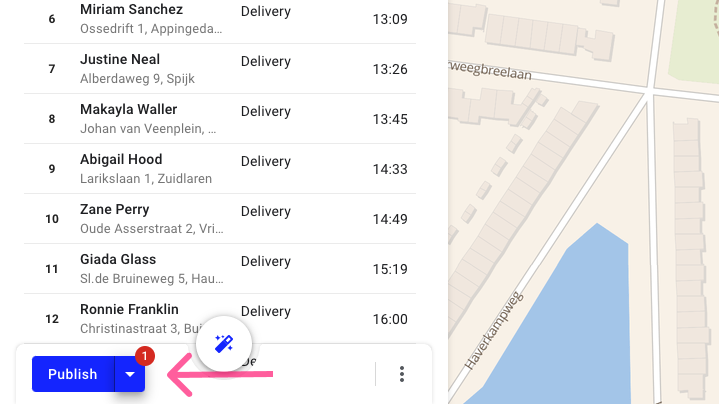
How to install the Routetitan Driver App on your drivers' phones 📱
The Routitan Driver Web App (DWA) can be installed on any device. It is a progressive web app, meaning it's downloadable from a website.
Installing it on an iPhone
Open the phone's browser and navigate to dwa.routetitan.com
Tap the 'Share' button
Scroll down and tap 'Add to Home Screen'
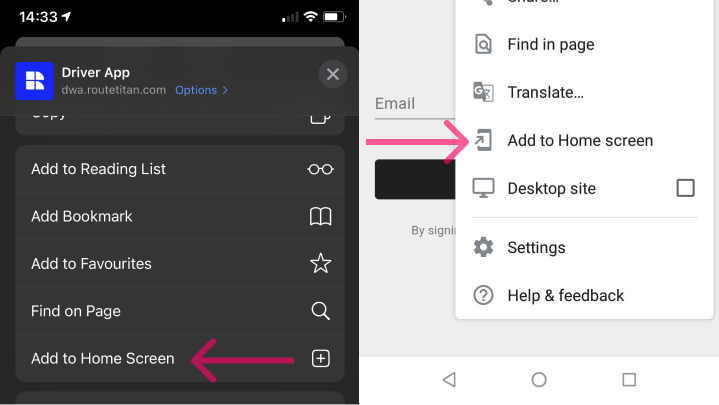
Installing it on Android
Open the phone's browser and navigate to dwa.routetitan.com
Tap the three-dot overflow menu in the top-right corner
Scroll down and tap 'Add to Home Screen'
After the last step, the Routetitan Driver App will show up on the home screen and is ready to use!
What will your drivers see?
When you publish the Project, it is sent to each of your drivers at their provided email address. From their Driver’s dashboard, they will be able to access several different panels to get directions, upload delivery confirmations and perform other tasks.
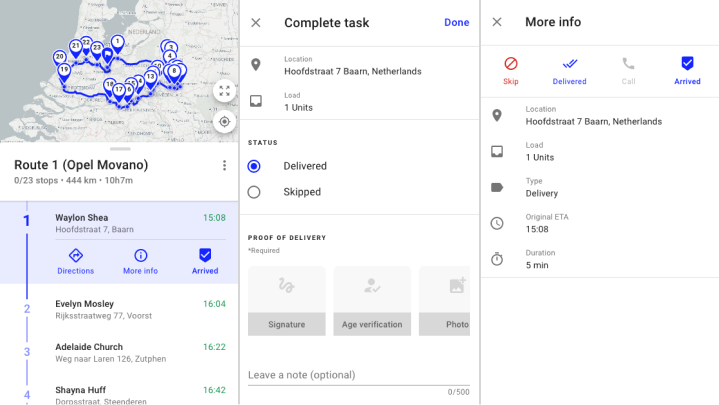
You can also copy a URL to the route and share it with your drivers or other members of your team.
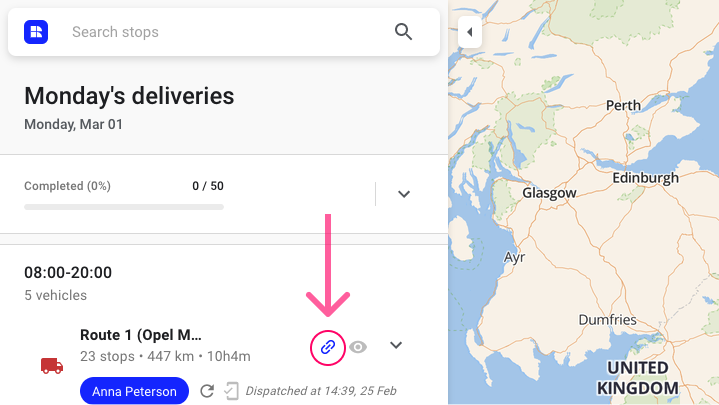
As your driver progresses through their stops, you can view their status from your central dashboard. This allows you to provide customers with up-to-date status information and monitor your fleet for delays or other issues.
Route optimization saves you time and money and reduces delivery planning hassles
To improve your profit margins, you need the power of technology. The math behind The Traveling Salesman Problem tells us that there are 362,880 routing choices for a single-vehicle, 10-stop route.1 Manually optimizing your routes isn’t an option.
Back in November, we built a multi-stop route using Google Maps to see how easy (or difficult) it was. Because Google Maps only chooses the shortest distance between two stops, not all stops--we had to try to find the best complete route ourselves.
That was not a fast or effective process.
Of course, I can’t make a direct comparison between manual mapping and automatic optimization because we were only able to add 10 stops and one vehicle to our Google Maps plan. Details such a shift length and delivery windows weren’t included either.
With Routetitan, on the other hand, optimization is fast and reliable.
Plus, because it only takes a few minutes to change a few variables and re-optimize your stops using Routetitan, you can experiment to find new ways to gain efficiency and provide better customer service. Just create a separate Project for testing purposes so you don’t overwrite your working routes.
Start realizing real savings and improving your customer service now
Is optimization worth it?
Fuel and labor costs account for 43% of motor carrier delivery costs. Our research indicates that last-mile delivery volumes will remain high even when the current economic conditions change. Customers’ expectations for fast, affordable service will too.
In my hypothetical, I discovered that I had the capacity to deliver more each day. I could use this information to move up some customers’ delivery dates. Maybe I could offer 1-day delivery at a premium fee or offer all of my customers narrower delivery windows. Alternatively, I could potentially reduce my fleet and still manage to meet all my delivery obligations.
But that’s just a hypothetical. You have real customers and real timelines to meet. So, I invite you to find out if optimization is worth it for yourself. Give Routetitan a try for 14 days. Explore its features and keep track of your results. Maybe even continue to do things the “old-fashioned” way and track those results too. Do a side-by-side comparison of your performance metrics.
Adjusting to a new way of doing things always takes a little time and effort. But if you follow this guide, I think you’ll be excited to discover how much more effective your fleet can be. And, once you do, I hope you’ll get in touch and tell me about it. I’d love to learn how Routetitan helps your business grow! 🌱
Onze nieuwsbrief